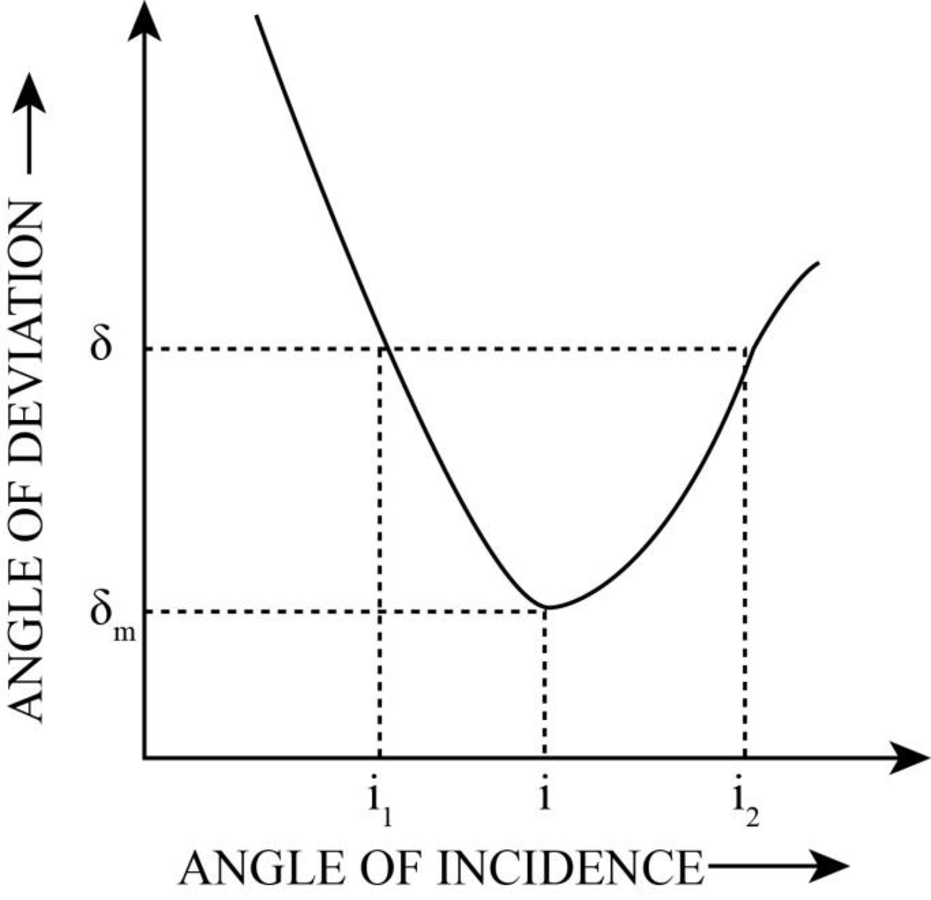
Concept explainers
(a)
The proof that total deviation of a ray from its original path is
(a)
Answer to Problem 124PQ
The total deviation of a ray from its original path is
Explanation of Solution
Write the expression for refraction law at left side of the given prism.
Here,
Write the expression for refraction law at right side of the given prism.
Here,
Write the expression angle of deviation of the given prism.
Here,
Write the relation among various angle from the geometry of the prism.
Substitute
Further solve this for
Use general trigonometric relation for conversion.
Substitute
Substitute
Substitute
Conclusion:
Therefore, it is proved that the angle of deviation is
(b)
The plot of the angle of deviation versus the angle of incidence for
(b)
Answer to Problem 124PQ
The graph is following.

Explanation of Solution
Write the expression for the angle of deviation of the given prism.
Conclusion:
Substitute
Deviation varies linearly, decreases and then increases approximately with incidence angle
Therefore, the plot of the angle of deviation versus the angle of incidence is as follows.

Figure-(1)
(c)
The incidence angle for which the derivation angle is minimum.
(c)
Answer to Problem 124PQ
The incidence angle for which deviation is minimum is
Explanation of Solution
The minimum deviation occurs when the incident and the refracted ray are identical and make equal angles to the normal of the prism.
The angle exhibits a minimum at
Conclusion:
The minimum angle of deviation depends on the refractive index for different wavelength, the refractive index is different.
Want to see more full solutions like this?
Chapter 38 Solutions
Physics for Scientists and Engineers: Foundations and Connections
- Figure P23.28 shows a curved surface separating a material with index of refraction n1 from a material with index n2. The surface forms an image I of object O. The ray shown in red passes through the surface along a radial line. Its angles of incidence and refraction are both zero, so its direction does not change at the surface. For the ray shown in blue, the direction changes according to n1 sin 1 = n2 sin 2. For paraxial rays, we assume 1 and 2 are small, so we may write n1 tan 1 n2 tan 2. The magnification is defined as M = h/h. Prove that the magnification is given by M = n1q/n2p. Figure P23.28arrow_forwardLight is incident on a prism as shown in Figure P38.31. The prism, an equilateral triangle, is made of plastic with an index of refraction of 1.46 for red light and 1.49 for blue light. Assume the apex angle of the prism is 60.00. a. Sketch the approximate paths of the rays for red and blue light as they travel through and then exit the prism. b. Determine the measure of dispersion, the angle between the red and blue rays that exit the prism. Figure P38.31arrow_forwardHow many times will the incident beam in Figure P34.33 (page 922) be reflected by each of the parallel mirrors? Figure P34.33arrow_forward
- A light ray is incident on an interface between water (n = 1.333) and air (n = 1.0002926) from within the air. If the angle of incidence in the air is 30.0, what is the angle of the refracted ray in the water?arrow_forwardLight traveling in a medium of index of refraction n1 is incident on another medium having an index of refraction n2. Under which of the following conditions can total internal reflection occur at the interface of the two media? (a) The indices of refraction have the relation n2 n1. (b) The indices of refraction have the relation n1 n2. (c) Light travels slower in the second medium than in the first. (d) The angle of incidence is less than the critical angle. (e) The angle of incidence must equal the angle of refraction.arrow_forwardA Lucite slab (n = 1.485) 5.00 cm in thickness forms the bottom of an ornamental fish pond that is 40.0 cm deep. If the pond is completely filled with water, what is the apparent thickness of the Lucite plate when viewed from directly above the pond?arrow_forward
 Principles of Physics: A Calculus-Based TextPhysicsISBN:9781133104261Author:Raymond A. Serway, John W. JewettPublisher:Cengage Learning
Principles of Physics: A Calculus-Based TextPhysicsISBN:9781133104261Author:Raymond A. Serway, John W. JewettPublisher:Cengage Learning Physics for Scientists and Engineers with Modern ...PhysicsISBN:9781337553292Author:Raymond A. Serway, John W. JewettPublisher:Cengage Learning
Physics for Scientists and Engineers with Modern ...PhysicsISBN:9781337553292Author:Raymond A. Serway, John W. JewettPublisher:Cengage Learning Physics for Scientists and EngineersPhysicsISBN:9781337553278Author:Raymond A. Serway, John W. JewettPublisher:Cengage Learning
Physics for Scientists and EngineersPhysicsISBN:9781337553278Author:Raymond A. Serway, John W. JewettPublisher:Cengage Learning College PhysicsPhysicsISBN:9781285737027Author:Raymond A. Serway, Chris VuillePublisher:Cengage Learning
College PhysicsPhysicsISBN:9781285737027Author:Raymond A. Serway, Chris VuillePublisher:Cengage Learning Physics for Scientists and Engineers: Foundations...PhysicsISBN:9781133939146Author:Katz, Debora M.Publisher:Cengage Learning
Physics for Scientists and Engineers: Foundations...PhysicsISBN:9781133939146Author:Katz, Debora M.Publisher:Cengage Learning College PhysicsPhysicsISBN:9781305952300Author:Raymond A. Serway, Chris VuillePublisher:Cengage Learning
College PhysicsPhysicsISBN:9781305952300Author:Raymond A. Serway, Chris VuillePublisher:Cengage Learning





